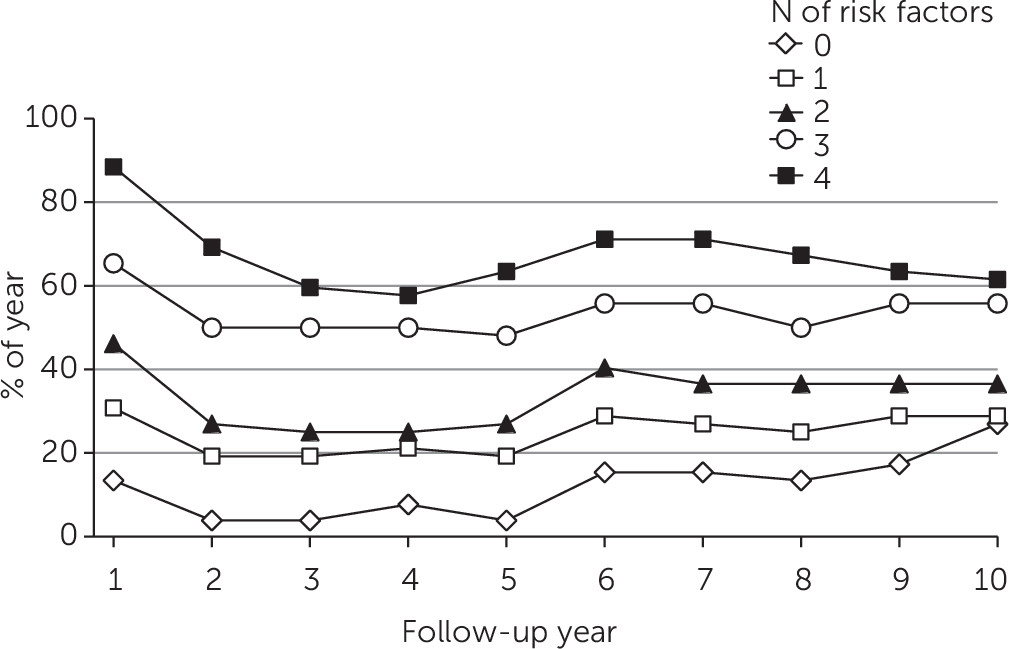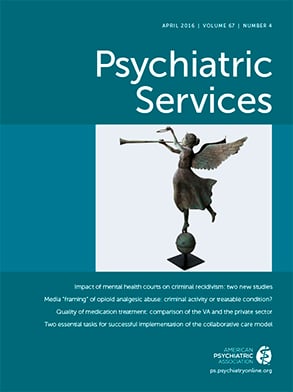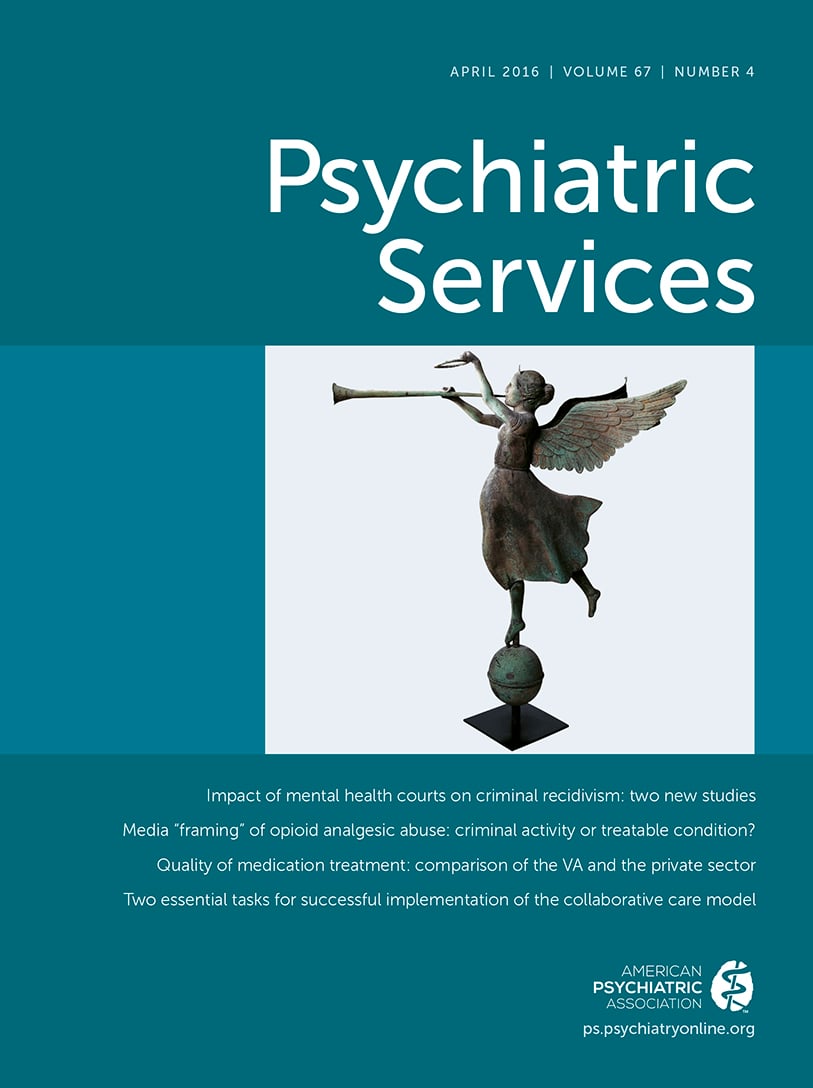Schizophrenia and other psychotic disorders have heterogeneous courses, with outcomes ranging from full recovery to severe and continuous symptoms. Identifying patients at risk of poor outcomes at an early stage can aid in treatment planning and focus resources. First-episode psychosis studies following patients from the onset of the disorder are likely to aid in identification of early predictors. Previous studies of predictors of poor outcome have identified one or more of the following: male gender, younger age at onset, being single, lower educational attainment, poorer premorbid adjustment, longer duration of untreated psychosis (DUP), concomitant drug abuse, and poor initial treatment response (
1–
12). In this study, we investigated to what extent these factors identify patients with poor outcome. Outcome was measured as the percentage of the ten-year follow-up period that a patient was psychotic. The study followed a large, representative sample of participants from their first week of treatment.
Methods
Participants
This study is part of the Scandinavian Early Treatment and Intervention in First-Episode Psychosis (TIPS) study (
13,
14). From 1997 through 2000, patients were recruited from Rogaland County, Norway; from Ullevål health sector, Oslo, Norway; and from Roskilde midsector, Denmark. The combined population of the three areas is approximately 665,000. All patients were provided a two-year standard treatment protocol, including antipsychotic medication, supportive psychotherapy, and multifamily psychoeducation (
13,
14).
Patients met the following criteria: residence in one of the study areas; age 18–65 years (age 15–65 in Rogaland County); met
DSM-IV criteria for schizophrenia, schizophreniform disorder, or schizoaffective disorder (that is, core schizophrenia spectrum disorder), brief psychotic episode, delusional disorder, affective psychosis with mood-incongruent psychotic features, or psychotic disorder not otherwise specified; actively psychotic as measured by a score of 4 (moderate) or higher for at least seven days on any of five items on the Positive and Negative Syndrome Scale (PANSS) (
15) (P1, delusions; P3, hallucinatory behavior; P5, grandiosity; P6, suspiciousness; and G9, unusual thought content); and willingness to provide informed consent. Exclusion criteria were neurological or endocrine disorders related to the psychosis, contraindications to antipsychotic medication, inability to understand or speak a Scandinavian language, IQ score <70, or inability to provide informed consent. Patients had not had any previous psychotic episode and had not received previous adequate treatment for psychosis (defined as antipsychotic medication of >3.5 haloperidol equivalents for >12 weeks or until remission of psychotic symptoms). In fact, 86% of the patients (N=260) proved to be drug naïve. A small group (N=16, 5%) had been taking antipsychotic medication in therapeutic doses before entry but for only a median of two weeks.
Of 397 eligible participants, 23% (N=93) refused to give informed consent. Those who refused had a longer DUP (median of 32 versus 10 weeks; Mann Whitney U test, p<.001) and were slightly older (30.4 versus 28.1 years; t=1.97, df=395, p=.05) (
16). Three patients (1%) withdrew their consent shortly after inclusion. A sample of 301 patients thus entered the study. At ten-year follow-up, 186 patients remained. Of the 115 patients lost to ten-year follow-up, 30 were dead, 49 refused follow-up, 23 did not attend their appointment, and 13 could not be traced. As a group, the 115 patients had a longer DUP than those who were available for follow-up at ten years (median of 17 versus six weeks; Mann Whitney U test, p=.016) (
17). For these patients, we used all available data until dropout. Nine of the 301 patients who entered the study were permanently lost before one-year follow-up, and they were excluded because of missing values for the dependent variable. This left a total of 292 patients for analysis in this study.
Measures
Assessments were carried out by specialized mental health personnel (clinical psychologist, psychiatrist, or psychiatric resident) at baseline, three months, and one, two, five, and ten years (mean±SD years to ten-year follow-up=10.4±.9). During the first two years, patients were also evaluated at least biweekly by their clinicians, who were in close contact with the research team. Data for years 3–5 were collected retrospectively at the five-year follow-up; for years 6–10, data were collected retrospectively at the ten-year follow-up. Data collections at five and ten years were based on patient information and all available clinical information.
When patients entered the study, the assessors estimated DUP by using all available information—from the patient interview, patient files, and family. DUP was defined as the time, in weeks, from psychosis onset to the start of the first adequate treatment of psychosis. Onset of psychosis was equated with the first appearance of being actively psychotic. Adequate treatment was defined as the start of structured treatment with antipsychotic medications or the start of hospitalization in highly staffed psychiatric wards organized to manage disturbing psychotic symptoms. All available information sources, including semistructured personal interviews with patients and relatives, were used to ascertain the length of this period. In the rare case of previous short, self-remitting psychotic episodes, the lengths of these episodes were added to estimate the DUP.
Premorbid functioning was measured by the Premorbid Adjustment Scale (PAS) (
18), which subdivides the premorbid period into childhood (ages 11 and younger), early adolescence (ages 12 to 15), late adolescence (ages 16 to 18), and adulthood (ages 19 and older). The final year before psychosis onset was not taken into account in the PAS evaluation to avoid including functional loss in the prodromal phase. As shown previously (
19), the scale measures two functional dimensions—social and academic. PAS scores were missing for six of the 292 patients. Among the remaining 286 patients, 111 (39%) had deterioration in premorbid social functioning.
The Structured Clinical Interview for DSM-IV was used for diagnostic purposes (
20). For analyses, diagnoses were dichotomized into core schizophrenia spectrum disorders and other psychotic disorders. Symptom levels were measured by five domains of the PANSS: positive, negative, cognitive, depressive, and excitative symptoms (
15,
21). Level of functioning was assessed with the Global Assessment of Functioning (GAF) (
22). GAF scores were split into symptom and function scores (
23). Alcohol and drug use for the six months before the start of treatment was assessed with the Clinician Alcohol/Drug Use Rating Scale (
24), which measures abuse on a scale from 1 to 5 (1, no use; 2, use without impairment; 3, abuse; 4, dependence; and 5, dependence with need for institutionalization). In this study, we dichotomized the scores, defining abuse as a score of ≥3.
Longitudinal measures were operationalized in the following ways. Remission was defined as at least one week with no score of ≥4 on any of the five PANSS items (P1, P3, P5, P6, or G9). Relapse was defined as at least one week with a score of ≥4 on any of the same items. Duration of psychosis was the number of weeks per year with a score of ≥4 on any of the five PANSS items. Psychotherapy was measured as the number of weeks per year of at least one session of supportive psychotherapy per week or every second week after remission. Medication was the number of weeks per year of treatment with antipsychotic medication. Hospitalization was the number of weeks in the hospital per year. We also calculated the percentage of the entire ten-year follow-up period that a patient was psychotic, was hospitalized, was on antipsychotic medication, and was in psychotherapy. For those who dropped out before the ten-year follow-up, we used the percentage of their shorter follow-up period. Reliability assessments were conducted and found to be satisfactory (
17,
25).
The project was approved by the Regional Committee for Medical Research Ethics Health Region II, the Regional Committee for Medical Research Ethics Health Region East, the Norwegian Data Inspectorate, the Norwegian Directory of Health, and the Regional Committee for Science Ethics Region Sjaelland in Denmark.
Statistical Analyses
Background characteristics used as predictor variables were male, age <23, single (never married, or with a partner for less than one year), education <13 years, and deterioration in premorbid social functioning as measured by the PAS. Predictor variables related to pathology at baseline were DUP ≥26 weeks, core schizophrenia spectrum disorder, and drug abuse. Rate of improvement—no remission within three months—was also included as a predictor variable. All variables were dichotomized to give optimal discrimination of time in psychosis during follow-up.
The statistical analyses were conducted with PASW Statistics, version 18.0 (
26). We used t tests to evaluate whether having a potential risk factor was associated with longer aggregated time in psychosis during follow-up. Factors associated with statistically significantly longer time in psychosis were kept for further analyses. To compensate for multiple comparisons, we set the cutoff for statistical significance at p<.01.
Longitudinal analyses were performed to assess whether the selected variables predicted time in psychosis over the entire follow-up period. To account for missing data and confounding variables, we used a linear mixed model, which has been recommended for repeated measures (
27). Model selection was based on restricted maximum likelihood, and nonsignificant covariates were excluded. The following equation describes the model:
Yij=(β1+b1i)+(β2+b2i)*time+β3*predictor+β4*predictor*time+eij
Yij is the time psychotic for patient i=1, . . ., 292 at year j=1 . . ., 10, j=1, . . . 10; eij is the error term; β1 . . . β4 are the fixed effects (population averages); and b1i and b2i are the individual specific random intercept and slopes. The interaction term between the predictor variable and time describes whether the group with a risk factor changes differently over time than those without the factor. We first ran the model with each predictor separately and then with several predictors to test their specific contributions. Residual analysis was carried out to assess the adequacy of the final model.
Results
Characteristics of the 292 patients are summarized in
Table 1. Among the 292 patients, the mean percentage of the follow-up period spent in psychosis was 35.9% (median=18.1%; range=.2% to 100%).
Table 2 shows the percentage of the follow-up period in psychosis by presence and absence of each of the risk factors. As shown, six of the nine variables were significantly (p<.01) associated with time spent in psychosis, the exceptions being gender, education, and presence of drug abuse at baseline.
The six variables were entered separately in a linear mixed-model analysis, where the dependent variable was the percentage of time in psychosis for each of the ten follow-up years. Of these, a DUP of ≥26 weeks, core schizophrenia spectrum disorder, and nonremission within three months were strongly significant predictors. Age <23 years, deterioration in premorbid social functioning, and being single were also statistically significant but somewhat weaker. The three weaker variables had about the same predictive strength as each other, but they were strongly interrelated, such that we could not test each variable’s specific contribution in the same model. Because we considered deterioration in premorbid social functioning to be the most basic underlying variable, we let it represent this group of variables in the final analyses.
Table 3 presents the results of the final linear mixed-model analysis. In this analysis we set the cut off for statistical significance at p<.05. All four variables made specific significant contributions to model fit (time in psychosis). Nonremission at three months also showed a significant interaction with time. These results suggest that all four variables independently predicted longer time in psychosis across the ten-year follow-up. As shown in
Table 3, the presence of deterioration in premorbid social functioning was related to an average increase of time in psychosis of 3.9 weeks a year over the ten-year follow-up. The presence of a core schizophrenia spectrum disorder was related to an increase of 5.4 weeks, and a DUP of ≥26 weeks was related to an increase of 4.4 weeks. The relationship was particularly strong for nonremission at three months, which predicted an increase of time in psychosis of 22.4 weeks in the first year. However, the interaction with time for this variable indicated a reduction of 1.35 weeks each year, so that the predicted increase for year 10 was reduced to 10.2 weeks. The effect of each variable was additive, as indicated in
Figure 1.
To rule out any effects of symptoms, we reran the analysis with PANSS positive and negative baseline symptoms as covariates. None of the PANSS variables reached statistical significance, whereas all the other variables remained statistically significant.
Discussion
The principal finding is that four baseline or early-course variables independently predicted time in psychosis over the first ten years of illness and that when combined, the variables also strongly predicted long-term outcome. This finding suggests that it is possible to assess the risk of poor long-term outcome more accurately after the first three months of treatment.
The importance of premorbid social functioning is in line with studies by White and colleagues (
10) and Albert and colleagues (
1), who found a clear relationship between premorbid social functioning and long-term outcome. White and colleagues found that DUP was also a significant predictor. A recent meta-analysis confirmed DUP as a long-term predictor (
28). Of note, Norman and colleagues (
29) found that early premorbid adjustment may act as a moderator of the relationship between DUP and outcome, insofar as DUP was related to outcome for patients with good premorbid functioning but not for those with poor premorbid functioning. However, contrary to Norman and coworkers, we found independent contributions of DUP and premorbid functioning, as measured by the PAS, on outcome, indicating that a long DUP had a significant impact, even for patients with poor premorbid functioning.
Schizophrenia is considered to be the most severe of the psychotic disorders, but diagnosis per se has not been identified as a predictor in any of the first-episode studies cited above. However, both White and colleagues (
10) and Albert and colleagues (
1) found that negative symptom scores predicted poor outcome. Because patients with core schizophrenia spectrum disorders in our study had a significantly higher level of negative symptoms than those without these core disorders, our results seem to point in the same direction. Lack of remission within three months was by far the strongest predictor, which is in line with the results of several previous studies (
2,
4,
9,
30,
31).
We chose to dichotomize the variables to simplify our analyses. The cutoffs were chosen to maximize discriminatory power in this sample, and they are similar to those used in the studies cited above. Our final statistical model excluded several variables previously identified as important predictors of outcome, including gender, age at onset, being single, and having high scores for positive and negative symptoms. These variables appear to tap into the same underlying severity factors and may be useful alternatives, but they did not add predictive power to our model.
Poorer outcome for patients with many risk factors might be a consequence of nonadherence to treatment. We found no indication that nonadherence could explain our results. On the contrary, we found that receipt of treatment (including use of clozapine) increased with an increasing number of risk factors. From our perspective, the most likely explanation is that the four predictor variables captured core elements of the huge variability in illness severity among patients with a first episode of psychosis and, furthermore, that a greater number of predictor variables indicates a more severe form of the disorder. However, we cannot exclude the possibility that treatment was suboptimal for more severely ill patients. Earlier identification and a more intensive treatment program might have helped some patients to a better course. We hope that the predictor variables in our study will help identify patients with particular treatment needs so that they can receive tailored treatment at an earlier stage.
The study had several strengths. The patient sample was highly representative of an unselected population of patients with first-episode psychosis. Patients were identified very early in the course of illness and treated according to a well-defined treatment program. In addition, patients were followed closely for the two first years, with further evaluations at five and ten years. We used all available clinical information collected by experienced clinical researchers, and satisfactory reliability of key variables was demonstrated throughout the study.
The study, however, had limitations. Our remission criteria were developed nearly 20 years ago and are based on definitions used in short-term treatment studies (for example, one week with a score of <4 on the PANSS items P1, P3, P5, P6, and G9). Newer remission criteria include negative symptoms and use a time perspective of half a year (
30). On the basis of previous studies of the TIPS sample (
17), we could expect baseline negative symptoms to play a more significant role. However, the few exploratory analyses that were possible in this data set indicated that application of the new remission criteria would have yielded only minor changes in our results.
Estimations of time in psychosis after year 2 were based on retrospective information at years 5 and 10. We included all available clinical information, but we cannot rule out the possibility of recall bias. Most probably this resulted in a tendency to underreport some fluctuations, especially during years 6 to 10.
A final limitation was that the number of patients was not large enough to allow for analysis of the predictor or moderator contribution of more variables.


